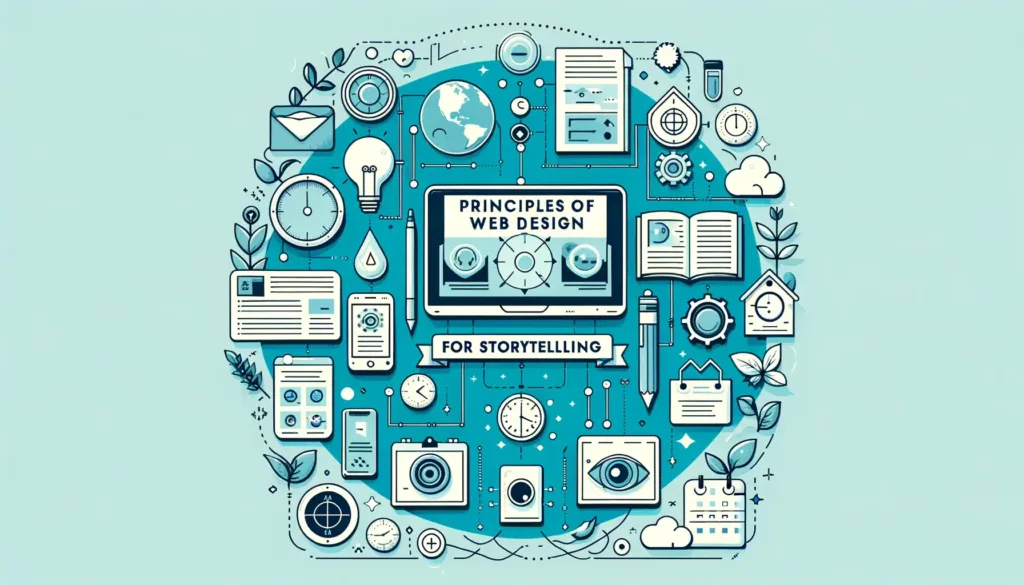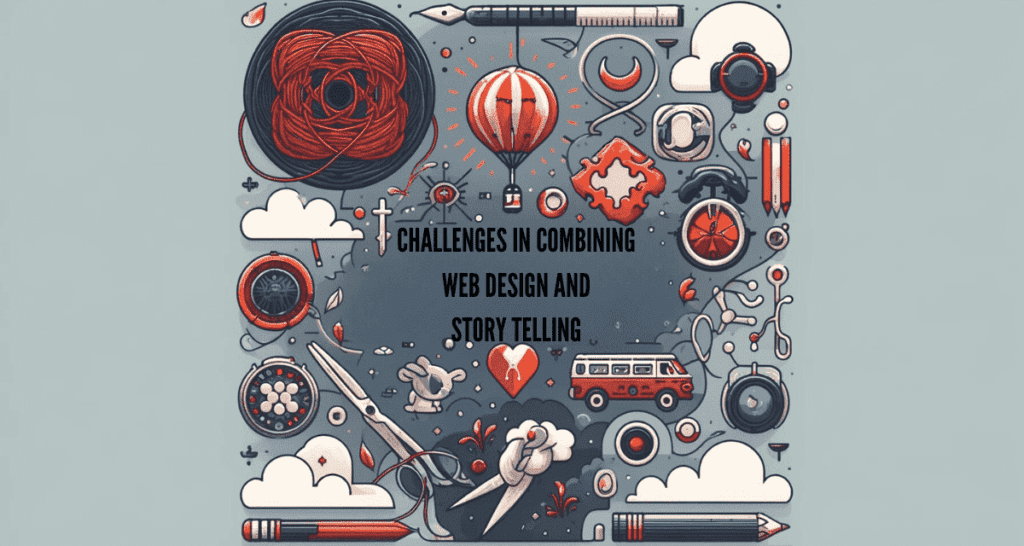Introduction
The Crucial Link Between Web Design and Digital Storytelling
In our digital era, storytelling is not just an art; it’s a game changing element of online engagement. Whether you’re a marketer, a content creator, or a business owner, understanding how web design influences storytelling can transform your content and captivate your audience. This article explores the role of web design in online storytelling, guiding you through its components, benefits, and strategic implementations.
The Essence of Storytelling in Digital Marketing


Understanding Online Storytelling
Storytelling in digital marketing is the craft of merging a narrative that engages customers on a personal level. Effective stories do more than sell a product; they inspire emotions and create connections. This makes storytelling a powerful tool in a marketer’s arsenal, helping to build brand loyalty and drive consumer actions.
The Evolution of Digital Storytelling
The evolution of storytelling has been marked by advancements in technology. From simple blog posts to immersive virtual reality experiences, the way we tell stories online has transformed drastically. Each technological leap provides new opportunities for marketers to craft compelling narratives that are not only heard but experienced.
Case Studies of Successful Online Storytelling
Dove’s “Real Beauty” Campaign: Dove used powerful video testimonials to tell the stories of real women, challenging beauty standards and sparking conversations worldwide.
Airbnb’s “We Accept” Campaign: Airbnb used a series of stories from hosts and travelers to promote a message of acceptance and diversity, enhancing their brand’s image as inclusive and global.
The Psychology of Web Design
Understanding the psychological impact of web design can greatly enhance the effectiveness of your storytelling. Certain colors possess specific emotions — blue can convey trust and stability, while red might invoke excitement or urgency. The layout can influence how information is processed; for instance, a well-structured website can make content more digestible and engaging. These psychological elements ensure that the story not only captures attention but also remains memorable.
There’s a guide written by us on The Role of Web Design in Digital Marketing Strategy.
Principles of Web Design for Storytelling


Strategic Layout to Guide the Viewer’s Journey
A strategic layout plays an important role in storytelling by guiding viewers through the narrative in a logical and engaging manner. For example, using a ‘Z‘ or ‘F‘ pattern layout can direct the user’s eye flow across the page, ensuring key elements of the story are seen in the intended order. This helps maintain the storyline’s clarity and enhances user engagement.
Enhancing Narratives with Visuals
Visuals such as images, videos, and animations are crucial for enriching the storytelling experience. They can express concepts quickly, adds emotions, and add depth to the narrative. For instance, an animated video can illustrate complex stories in an understandable and relatable way, making the narrative more accessible to a broader audience.
Typography and Readability
The choice of typography affects how easily the text can be read and how well it complements the overall narrative. Fonts should be clear and easy to read, with adequate spacing and size to ensure accessibility and comfort. For instance, a sans-serif font like Arial or Helvetica is often used for its readability and modern appearance, which can be ideal for contemporary stories.
Interactive Elements to Engage Users
Interactive elements such as clickable buttons, scroll-triggered animations, and hover effects can significantly increase user engagement. These elements invite the audience to participate in the story, creating a more immersive and memorable experience. For example, a storytelling site might use hover effects to reveal more information about characters or plot details, engaging the user to interact directly with the story.
Web Design Techniques That Enhance Storytelling


Case Studies: Examples of Websites Successfully Integrating Design with Storytelling
Google’s “Year in Search” Campaign
Google’s annual “Year in Search” videos showcase the power of integrating multimedia and layout to tell a compelling story of the year’s major events. The campaign uses a combination of impactful imagery, videos, and keyword searches to narrate a global story that resonates with millions.
Spotify’s “Wrapped” Campaign
Spotify’s “Wrapped” feature provides users with a personalized end-of-year review. Using vibrant graphics, dynamic layouts, and interactive elements, Spotify crafts a unique story for each user about their yearly listening habits, effectively making data-driven storytelling personal and engaging.
Parallax Scrolling for Depth and Dynamism
Parallax scrolling is a technique where background elements move slower than foreground content, creating an illusion of depth on the web page. This can be used effectively to draw users into the story, making the journey through the content feel more dynamic and engaging. It’s particularly effective in storytelling because it mimics the cinematic technique of depth focus, which can emphasize important narrative elements.
Multimedia Integration to Enhance Narrative Delivery
Integrating multimedia elements like audio, video, and animations can significantly enhance the narrative by providing additional layers of context and emotion. For instance, background music can set the mood, while videos can show rather than tell key parts of the story, creating a richer user experience.
Responsive Design for Cross-Device Storytelling
Ensuring your story is effectively told across all devices is critical. Responsive design adapts your website’s layout to the viewing environment, providing an optimal experience on mobile phones, tablets, and desktops. This consistency ensures that the story is accessible and engaging, regardless of how or where it is viewed.
here’s our discovery on Maximizing Content Visibility Through Strategic Web Design.
Challenges in Combining Web Design and Storytelling


Balancing Aesthetics with Functionality
One of the primary challenges in integrating web design with storytelling is maintaining a balance between visual aesthetics and website functionality. While compelling graphics and animations can significantly enhance a story, they must not lower the website’s performance or navigability. Overloading a site with heavy media files can lead to slow loading times, negatively impacting user experience and SEO rankings.
Optimizing for Speed and SEO While Maintaining Rich Media Content
Ensuring that a story-rich website is also optimized for search engines can be a hectic task. SEO requires that websites load quickly, use the correct keywords, and are easy to navigate. However, multimedia elements, which are crucial for storytelling, can affect loading speeds and mobile responsiveness. Using optimized images, leveraging browser caching, and minimizing code are critical steps to address these issues without sacrificing story quality.
Accessibility: Making Stories Accessible to All Audiences
Accessibility is crucial in web design, especially when telling stories intended for diverse audiences, including those with disabilities. Designers must ensure that their websites are accessible through keyboard navigation, screen readers, and by providing alt text for images and transcripts for videos. Ensuring accessibility not only broadens the audience but also complies with legal standards, making the web a more inclusive space.
SEO Strategies for Story-Driven Web Design


Importance of SEO in Storytelling
SEO is vital in ensuring that your storytelling efforts reach as wide an audience as possible. A well-optimized story not only attracts more viewers but also engages them effectively, increasing the likelihood of conversions and shares. This makes understanding SEO strategies fundamental for anyone involved in digital storytelling.
SEO Best Practices for Story-Driven Design
Optimized Images and Videos
Images and videos are integral to storytelling but can affect page load speed and user experience if not properly optimized. Compressing media files, using appropriate file formats (like WebP for images and MP4 for videos), and providing alt text are essential for SEO. Also, hosting videos on platforms like YouTube or Vimeo and embedding them on your site can help manage loading times while still engaging users visually.
Narrative-Driven Keywords
Choosing the right keywords is crucial for SEO. These should reflect the narrative elements of your story and be woven seamlessly into your content. Keywords should be relevant to the story you are telling and the audience you are targeting, ensuring they appear naturally within the content to maintain readability and engagement.
This is important to read for detailed understanding How Web Design Influences SEO in 2024.
Predictions for Storytelling and Web Design Evolution
In the next decade, storytelling through web design will likely become even more interactive and immersive. We can expect to see:
Increased integration of multimedia elements like live videos and interactive graphics.
More personalized content delivery, where stories adapt in real-time to user feedback.
Greater emphasis on mobile-first design as mobile usage continues to rise.
These advancements will require web designers and storytellers to continuously innovate and adapt, ensuring their narratives not only capture but also hold the attention of increasingly sophisticated audiences.
Conclusion
Recap of Key Points
In this article, we explored the pivotal role of web design in enhancing online storytelling. From the essential components and principles of web design to the integration of advanced techniques and SEO strategies, it’s clear that effective web design is crucial for crafting compelling digital stories. We also looked ahead to the future trends that will shape storytelling in the digital age.
- Leveraging Analytics for Web Design Optimization - April 30, 2024
- The Role of Artificial Intelligence in Web Design - April 29, 2024
- How to Create an Inclusive Web Design - April 26, 2024

